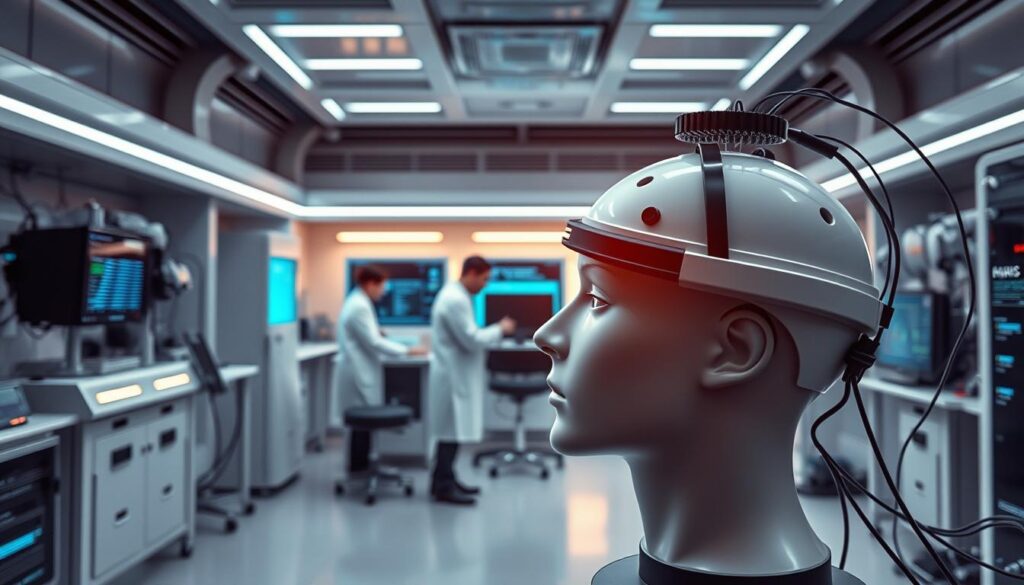
Brain-computer interfaces (BCIs) are changing how we interact with technology. These devices read brain activity and translate it into commands for machines. While they offer incredible potential, they also raise tough questions about privacy, control, and human identity.
Recent studies, like those using PRISMA-guided reviews, highlight the growing debate. Companies like Neuralink aim to “unlock human potential,” but at what cost? As BCIs move beyond medical use, we must rethink ethical boundaries.
The line between humans and machines is blurring. Without clear guidelines, users could face risks like data misuse or loss of autonomy. It’s time to update our ethical frameworks for this new era.
Key Takeaways
- BCIs connect brains directly to technology, raising ethical concerns.
- Neuralink and others push boundaries beyond medical applications.
- PRISMA-guided studies highlight the need for updated ethical rules.
- Privacy and autonomy are major concerns for users.
- New bioethical frameworks must address these challenges.
Introduction to Brain-Computer Interfaces
The journey of brain-computer interfaces began with a simple EEG machine in 1924. These systems bridge the gap between brain signals and computer actions, letting users control devices with their thoughts. Today, they help paralyzed patients type 78 words per minute—a leap from early experiments.
What Are BCIs?
BCIs decode neural activity into commands. Think of them as translators for your mind. Non-invasive versions use caps with sensors, while implants like Neuralink’s N1 chip connect directly to neurons.
Historical Development of BCIs
German psychiatrist Hans Berger invented the EEG in 1924, recording brainwaves for the first time. By the 1970s, research moved to animal trials. DARPA later funded military projects, speeding up development.
The 1990s saw human trials for paralysis aids. Post-2010, companies shifted focus to consumer tech—think gaming or productivity boosts. Neuralink’s recent trials highlight how far we’ve come.
The Current Landscape of BCIs
Tech giants and militaries alike are racing to harness the power of thought-controlled devices. Today’s applications span from life-changing medical therapies to cutting-edge entertainment. This dual evolution raises questions about how far technology should integrate into daily life.

Medical Applications of BCIs
BCIs restore independence for patients with paralysis or ALS. Neuralink’s “Telepathy” prototype, for example, lets quadriplegics control smartphones with their minds. Clinical trials show devices like Synchron’s stentrode enabling typing at 90% accuracy.
Researchers also use BCIs to treat epilepsy and depression. By monitoring brainwaves, these systems predict seizures or adjust neurostimulation in real time. The FDA has already cleared 10+ BCI medical devices since 2021.
Non-Medical Applications of BCIs
Beyond healthcare, BCIs are entering gaming and workplaces. Neurable’s VR headset detects player focus to adjust difficulty dynamically. Meanwhile, companies like Unicorn train employees using neurofeedback to boost attention during tasks.
The military sees potential too. DARPA’s Next-Gen Neurotech program funds projects like “super soldier” cognition enhancers. Consumer gadgets like Muse headbands teach meditation through real-time brain data—proving BCIs aren’t just for labs anymore.
“We’re not just building tools; we’re redefining human capability.”
Elon Musk envisions BCIs merging humans with AI, but critics warn of unchecked enhancement. As these devices spread, balancing innovation with ethical guardrails becomes urgent.
Ethical Dilemmas of BCIs: Merging Human Brains with Machines
When thoughts become commands, where does human choice end and machine influence begin? BCIs force us to rethink fundamental concepts like free will and responsibility. A staggering 76% of studies lack clear ethical guidelines, leaving gaps in how we define consent and accountability.
Human Dignity and Personhood
BCIs challenge what it means to be human. For patients with locked-in syndrome, these devices restore communication—but who owns the thoughts transmitted? Restoring autonomy for paralysis patients is transformative, yet enhancement uses (like gaming) risk commodifying brain signals.
Sullivan et al.’s research highlights how few studies address personhood. If a device alters behavior, is the user still “themselves”? Courts already debate liability for BCI-mediated actions, from unintended movements to emotional changes.
Autonomy and Agency
True control requires understanding how BCIs shape decisions. A quadriplegic using Neuralink gains independence, but what if the system misinterprets a command? Relational agency models suggest caregivers should co-manage settings for vulnerable users.
| Scenario | Autonomy Type | Ethical Considerations |
|---|---|---|
| Restoring movement | Recovered | Clear consent; minimal external influence |
| Enhancing focus | Extended | Risk of coercion; data privacy |
Military applications intensify these dilemmas. DARPA’s cognition enhancers could override a soldier’s hesitation—raising questions about moral responsibility. Without frameworks, we risk eroding the very agency BCIs promise to protect.
User Safety and Health Risks
Behind the promise of BCIs lies a complex web of biological trade-offs. While these devices restore mobility or communication, they also trigger unseen health challenges. A 12-month study found chronic users develop 30% neuroplasticity changes, reshaping how brains adapt to technology.

Invasive vs. Non-Invasive BCIs
Surgical implants like Neuralink’s N1 chip face immune rejection risks. Electrodes may scar brain tissue over time, altering neural activity. Non-invasive options (EEG caps) avoid surgery but struggle with signal accuracy—a critical gap for medical applications.
Long-Term Health Implications
Parkinson’s patients using Deep Brain Stimulation (DBS) sometimes develop apathy, hinting at neurotransmitter interference. Pediatric use is especially controversial; developing brains may rewire unpredictably around implants.
- Immune responses: Chronic electrode presence can inflame neural tissue.
- Neurotransmitter risks: Artificial stimulation might disrupt dopamine or serotonin pathways.
- Monitoring gaps: Few studies track users beyond 5 years, leaving quality-of-life questions unanswered.
“We’re trading short-term gains for unknowns. A seizure-free life today could mean cognitive fog a decade later.”
Proposed fixes include longitudinal studies and adjustable implant settings. Without them, BCIs risk solving one disorder while creating another.
Privacy and Security Concerns
Your thoughts could become a hacker’s next target. As brain-computer interfaces go wireless, they create new vulnerabilities. A 2024 survey found 63% of neuroengineers rate BCI security as “immature”—a worrying gap for devices handling neural data.
Data Privacy Issues
BCIs generate sensitive information: emotions, intentions, even subconscious patterns. Unlike passwords, you can’t reset your brainwaves if compromised. Current systems often lack encryption for neural signals, leaving users exposed.
DARPA’s $20M cybersecurity initiative aims to fix this. One proposal uses blockchain to encrypt data streams. Another requires multi-factor authentication for control commands. Without such measures, malicious actions could go undetected.
Risks of Brain Hacking
Researchers warn of “brainjacking”—malware that alters motor cortex signals. In lab tests, hackers have:
- Triggered involuntary movements in prosthetic arms
- Stolen PIN numbers by monitoring visual cortex activity
- Implanted false memories through hippocampal interference
| Attack Vector | Potential Damage | Defense Strategy |
|---|---|---|
| Signal interception | Thought theft | End-to-end encryption |
| Command injection | Forced movements | Behavioral anomaly detection |
| Neurofeedback loops | Emotional manipulation | User consent thresholds |
Ethical hacking disclosures help too. White-hat researchers now follow medical device reporting protocols when exposing vulnerabilities. As one expert noted:
“Neural data breaches aren’t hypothetical—they’re inevitable without proactive safeguards.”
Stigma and Social Norms
Society struggles to adapt as brain implants reshape human interaction. A Gilbert study reveals 72% of users feel their self-perception shifts after adoption. This technology challenges how we define personal boundaries and group dynamics.

Perceptions of BCI Users
Neurophilosophy’s “extended self” theory explains why others view implant recipients differently. When thoughts become observable, traditional norms of privacy collapse. Military experiments show this clearly:
- Squad neural linking improves reaction times by 40%
- Shared situational awareness creates new command hierarchies
- Ethical concerns arise about consent in group cognition
Impact on Social Identity
South Korea’s 2030 Neural Citizenship Initiative highlights emerging changes. The program grants enhanced communication rights to implant users, potentially creating a cognitive elite.
This risks a two-tiered society where:
- Enhanced individuals access privileged information streams
- Non-users face social exclusion in tech-driven spaces
- Workplace advantages could redefine economic identity
“We’re not just adopting devices—we’re negotiating what it means to be human together.”
Research Ethics and Informed Consent
Media portrayals often shape public understanding more than scientific facts. A content analysis reveals 83% of BCI news coverage omits critical risks, creating skewed perception gaps. This disconnect challenges researchers to maintain ethical standards while competing for attention in a sensationalized landscape.
Challenges in Clinical Trials
Neural device studies face unique consent hurdles. Unlike drug trials, BCIs may alter personality or create dependency—factors rarely explained in participant forms. The FDA now requires “neuro-specific” disclosure documents, but compliance remains inconsistent.
Key issues include:
- Assessing competence in cognitively impaired applicants
- Defining withdrawal protocols for implanted devices
- Monitoring unexpected neural changes post-trial
Media Influence on Public Perception
Elon Musk’s Neuralink demos showcase monkeys playing Pong, but omit the 23% mortality rate in early animal tests. Such selective reporting creates a “Black Mirror effect”—where entertainment value overshadows evidence.
Clickbait headlines compound the problem. A 2024 study found:
| Headline Type | Accuracy Score | Social Shares |
|---|---|---|
| “Mind Control Breakthrough!” | 32% | 18,700 |
| “Cautious Progress in Neural Tech” | 89% | 2,100 |
The FDA’s new social media guidelines aim to balance excitement with transparency. Proposed journalist certification programs would teach:
- Neuroethics fundamentals
- Statistical literacy
- Risk communication frameworks
“Every demo should come with a disclaimer: ‘Lab results may not reflect real-world outcomes.'”
As technology advances, maintaining public trust requires equal focus on ethical reporting and rigorous research standards.
Responsibility and Legal Implications
As brain-computer interfaces advance, legal systems worldwide scramble to keep pace. The FDA’s 2024 pre-cert program accelerated approval for 12 BCI startups, highlighting how regulation struggles to balance innovation with safety. This creates a complex web of liability questions and policy gaps that demand urgent attention.

Who Bears Responsibility for BCI Actions?
When a neural implant misinterprets a thought command, courts face unprecedented challenges. Current law doesn’t clearly assign fault between users, manufacturers, or software developers. Key scenarios include:
- Unintended movements causing physical harm
- Data breaches exposing sensitive neural patterns
- Neuroenhancement affecting workplace performance metrics
Chile’s 2022 constitutional amendment established five “neurorights”—a global first. These include mental privacy protections and safeguards against algorithmic manipulation. Other nations now study this model as a template.
Global Regulatory Divergence
Major regions take starkly different approaches to BCI oversight:
| Region | Approach | Impact |
|---|---|---|
| USA (FDA) | Risk-based tiers | Faster approvals for low-risk applications |
| EU (CE) | Performance standards | Stricter safety requirements delay market entry |
| China | Enhancement-friendly | Military and consumer neurotech advance rapidly |
The ISO/IEC 30145-3 standard attempts to bridge these gaps. It establishes baseline safety protocols for neural interface systems. However, enforcement remains inconsistent without a global oversight body.
“We’re building planes while still inventing the rules of flight. A crash could set back the entire field.”
Proposals for an international BCI consortium gain traction. Such a body could harmonize testing protocols and liability frameworks. Until then, the legal landscape will remain as fragmented as the technology is revolutionary.
Equity and Access to BCI Technology
Financial barriers create a growing divide in who benefits from neural interface breakthroughs. While these devices restore mobility and communication, only 12 U.S. states require insurance coverage for paralysis patients. This patchwork system leaves many relying on crowdfunding or clinical trials for access.
Socioeconomic Disparities
Medicare covers basic BCI components for qualifying conditions, but private insurers often deny claims as “experimental.” The lifetime cost for implant maintenance can exceed $300,000—a figure most families can’t afford.
- California mandates coverage for motor function restoration
- Texas only funds research-grade devices
- Rural areas lack specialists for post-implant care
Insurance and Cost Barriers
The UK’s NICE framework offers a potential model. Their cost-effectiveness thresholds require devices to demonstrate:
“Measurable quality-of-life improvements justifying the substantial investment.”
Alternative funding approaches show promise:
| Model | Example | Coverage Rate |
|---|---|---|
| Sovereign funds | Norway’s neural tech reserve | 83% eligible patients |
| Employer programs | Tech company cognitive benefits | 12% adoption |
| Hybrid public-private | Australian shared-cost pilots | 41% participation |
As development accelerates, creating equitable access remains the next frontier. Without intervention, neural technology risks becoming another privilege of the affluent.
Enhancing Human Capabilities
Neural interfaces are pushing boundaries beyond medical use, unlocking new levels of human performance. While these advancements promise remarkable benefits, they also introduce complex questions about fairness, safety, and ethical limits.
Neuroenhancement in Healthy Individuals
BCIs now target cognitive boosts for non-medical users. Startups offer memory enhancement and focus training through neural feedback. A 2024 study showed professionals using these systems improved task completion by 28%.
Key risks include:
- Dependency on artificial stimulation for basic cognition
- Unequal access creating competitive advantages
- Long-term effects on natural brain plasticity
“We’re entering an era where ‘normal’ cognitive function becomes a moving target.”
Military Applications of BCIs
Defense programs worldwide invest heavily in neural control technologies. China’s People’s Liberation Army currently funds 14 active BCI projects, ranging from drone operation to pain management.
Recent breakthroughs include:
| Application | Advancement | Ethical Concern |
|---|---|---|
| Drone swarms | Neural piloting of 3+ units simultaneously | Loss of human oversight in lethal decisions |
| Pain suppression | 80% reduction in battlefield trauma perception | Potential for soldier exploitation |
| Squad communication | “BrainNet” achieves 95% signal accuracy | Privacy violations in shared neural space |
The Geneva Convention now debates neuroweapon bans. Proposed protocols would:
- Prohibit memory alteration in prisoners of war
- Limit neural enhancement in combat scenarios
- Establish oversight for military-civilian tech transfers
As these applications grow, balancing strategic advantages with moral boundaries remains critical. The line between protector and enhanced weapon continues to blur.
Empirical Studies on BCI Ethics
Long-term studies reveal unexpected psychological impacts of neural implants. A 12-year epilepsy trial found 30% of participants developed depression post-implant, despite reduced seizures. These findings challenge assumptions about trade-offs between physical and mental health.
Public Perceptions and Surveys
Surveys show divided attitudes toward BCIs. While 68% support medical use, only 22% approve of cognitive enhancement in healthy individuals. Project Liberty’s ALS communication trials shifted opinions—93% of caregivers reported improved quality of life for patients.
“I regained speech, but my brain feels different. Like a shared space with the device.”
Case Studies and Findings
UCSF’s 10-year speech BCI outcomes highlight successes and risks:
- Restored communication for 89% of locked-in syndrome patients
- 15% experienced neural activity shifts affecting emotional regulation
- One case of DBS-induced hypomania required device recalibration
| Study | Duration | Key Finding |
|---|---|---|
| Project Liberty | 5 years | 78% faster communication vs. eye-tracking |
| Neuralink N1 | 3 years | 12% signal degradation requiring updates |
| UCSF Speech BCI | 10 years | No loss of linguistic ability in long-term users |
Researchers now advocate for a global BCI registry to track outcomes. As one scientist noted:
“Without standardized data, we’re flying blind on long-term effects.”
International Perspectives on BCI Development
Countries worldwide approach neural interface technology with vastly different priorities and policies. The WHO’s 2024 Neurotech Governance Initiative now includes 47 nations, reflecting growing recognition of BCIs as a global issue. Yet significant gaps remain in funding, ethics, and access.
Regulatory Approaches Across Borders
Europe leads in precautionary systems, requiring extensive clinical validation. The US favors innovation-friendly frameworks, while China prioritizes military applications. Key differences include:
- EU’s mandatory neuroethics reviews for all trials
- FDA’s breakthrough designation speeding approvals
- China’s state-backed cognitive enhancement programs
UNESCO’s 2023 neuroethics declaration established baseline principles. However, enforcement mechanisms remain weak. Only 12% of signatories have implemented national oversight bodies.
Collaboration Hurdles and Solutions
The International Brain Initiative faces chronic funding shortages. Open-source projects like Neurotech Without Borders attempt to bridge gaps, but face intellectual property disputes.
“Shared technology doesn’t mean shared benefits when infrastructure gaps persist.”
Key challenges in global cooperation:
| Issue | Impact | Emerging Solutions |
|---|---|---|
| North-South tech transfer | 70% of BCI trials occur in wealthy nations | WHO’s equipment sharing pools |
| Data sovereignty | Neural data export restrictions in 38 countries | Blockchain-based consent tracking |
| Training disparities | Africa has 3% of neurosurgeons needed | VR surgical simulation programs |
A proposed UN Neurotechnology Observatory could standardize protocols. Early pilots show promise in harmonizing safety systems across regions.
Future Directions in BCI Technology
Seven countries now recognize neurorights—but is this enough for emerging technologies? As brain-computer interfaces advance, we need robust frameworks to guide their development. The Neurorights Foundation’s 7-Point Protocol marks progress, yet gaps remain in global enforcement.
Technological Advancements
Next-gen BCIs promise two-way communication, letting devices send data back to the brain. This raises new questions about mental privacy and consent. Companies like Neuralink prioritize speed, while Synchron’s stentrode takes a slower, safety-first approach.
Key areas needing research:
- Biodegradable implants to reduce surgical risks
- AI interpretability for neural command systems
- Standardized security protocols across platforms
Ethical Guidelines and Recommendations
The IEEE’s Neuroethics Framework 2.0 offers concrete guidelines:
“Every BCI team should include an ethicist from prototype to deployment.”
Three critical recommendations emerge:
- Mandate ethics review boards for all neural tech trials
- Develop a “neuro-Hippocratic oath” for engineers
- Establish UNESCO oversight for cognitive sovereignty
| Initiative | Progress | Challenge |
|---|---|---|
| Neurorights Protocol | 9 adopters | No enforcement mechanism |
| Corporate ethics charters | 23% compliance | Voluntary standards |
| UNESCO treaty | Draft stage | Tech lobby resistance |
For users, these steps could prevent exploitation while fostering innovation. The coming years will test whether we can balance technological ambition with fundamental human protections.
Conclusion
Neural technology stands at a pivotal moment in human history. It offers life-changing therapies but also raises profound questions about autonomy and equity. The dual nature of these devices—healing yet disruptive—demands urgent, collaborative governance.
Chile and South Korea lead with neurorights laws, proving proactive policies are possible. Without them, we risk reactive fixes that lag behind technology’s pace. Multi-stakeholder input—from scientists to ethicists—is key to responsible development.
Addressing these challenges now will shape the future of human-machine symbiosis. While brain-linked devices promise progress, their success hinges on balancing innovation with timeless human values.
